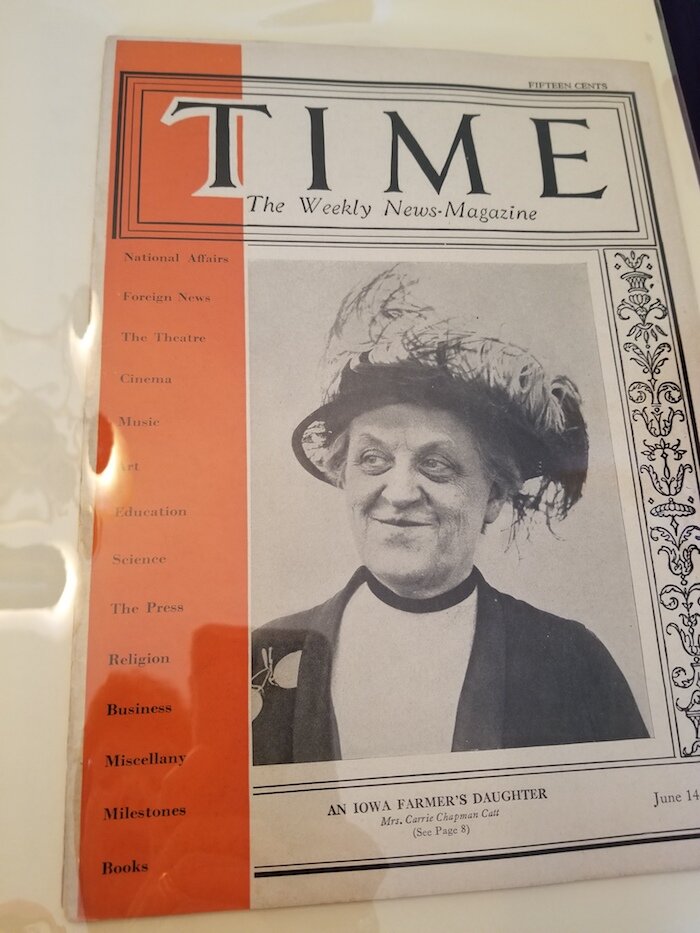BY BARBARA MATUSOW
Entering Anne Lewis’s sunny apartment in Chevy Chase for the first time, you expect to find the place bulging with suffrage memorabilia. That’s because Anne has one of the largest private collections– nearly 1300 items– in the country. What you’ll find, instead, is a handful of items in a small, glass-fronted cabinet: cups and saucers, figurines, spoons, a small pennant, playing cards, buttons, and other objects that say “Votes for Women.”

She owns many more objects like these, known in the trade as 3-D. But the heart of her remarkable collection resides in the large leather-bound albums, arranged chronologically, that take up several shelves in the bookcases. They hold the paper items she treasures–primary documents such as letters written by movement co-founder Susan B. Anthony, strategy documents written by Carrie Chapman Catt, who led the final drive for ratification of the 19th amendment, petitions, resolutions, campaign handbills, books, periodicals, post cards, even a 1915 invoice for $1.00 sent to the New York State suffrage committee and stamped “Long Overdue.”
To some, a 100-year-old, yellowing invoice would look like junk. To Lewis, a veteran Democratic party strategist and sister of former Congressman Barney Frank, it’s an invaluable clue to a pressing question. “I want to know: what did these women say to voters?,” she says. “When 100 percent of your targets were men, what was the message and how did you get it to them? How did these women win in the end, given how meager their resources were and how little support they had from the general public?”
She points out a flyer dated 1915 that says, “Not at home,” which would have been left at the door by a canvasser. “Just like today, women back then knocked on doors,” she says. “They distributed literature. They circulated petitions. They organized. It’s exactly the same thing we have to do today to win elections.”
Lewis started her suffrage collection almost by accident. She and her husband, Mike Sponder, were strolling in Faneuil Hall in Boston in the early 70’s, when a framed piece of newsprint caught her eye. Dated 1870, it said “Women’s Suffrage Bazaar “and appealed for handmade articles, books and food—items the suffragists would sell to pay for lecturers, pamphlets, and the like. “We picked this up for $3.50,” she says. “There was not so much interest in suffrage then, and you could find a lot of amazing stuff. From that moment on, I was hooked.”
She and Mike started prowling used book shops, flea markets, and shows for collectors, never knowing what would turn up. “One day we were taking a walk in Chelsea in New York City and we stopped by a second-hand shop in an old, converted garage, recalls Lewis. “ We asked the proprietor if he had any Susan B. Anthony or Elizabeth Cady Stanton [Anthony’s collaborator and movement co-founder.] ‘Yeh,’ he said. ‘I got something like that.’ So he disappears into the back room and comes out with a box containing an entire run of ‘The Revolution.’ We couldn’t believe it.!” [The Revolution was the newspaper that Stanton and Anthony put out from 1868 to 1872.]
“It’s hard to remember what we paid now,” says Mike, who does the negotiating for the couple. “It was probably around $10 a page. Today, you might pay $50 or $60 a page—that is, if you could find any copies.”
Today, instead of fairs and second-hand book shops, nearly all the buying, selling and trading is done on line. But according to Mike, most of the good stuff is gone. “Take a look at eBay,” he says. “If I type in suffrage, maybe 4,000 items will come up. But most of the stuff is reprints and copies. Once in a while you’ll find something like a letter written by Susan B. Anthony, but mostly it’s mundane stuff. it’s rare when anything of value turns up.”
Even so, a dedicated collector can still stumble on some real bargains. Lewis made one of her greatest finds on eBay just three or four months ago. She came across a group of items including two letters written by Carrie Catt, a printed program from a 1915 suffragist dinner, and a receipt for $1.00 for 100 campaign buttons. The Catt letters are particularly fascinating. Each of them three or four pages long, they lay out her instructions for her field teams during the 1915 suffrage campaign in New York State. Amazingly, Lewis picked up the lot for only $160. “I was stunned that nobody had swept in and bought it. When I hit “buy” on the computer, I was quivering with excitement” she says.

the 19th amendment ratified.
Given the breadth and importance of her collection, the question naturally arises: What does Lewis, who 81, plan to do with it. The Library of Congress and the National Archives have amazing treasures, for example, but Lewis points out that their focus is not on suffrage, so the items in her collection would only be on display intermittently. “I haven’t seen an institution yet that is as focused on access as I would like. They are focused on preservation which is good. The Library of Congress has a great exhibit right now, but the items are not on display most of the time. “
One thing seems sure; Lewis has no plans to monetize the collection. Recently, she created a searchable website where people can view the photos of all the items and even borrow them at no cost. “The reason I do this is to tell the suffrage story,” she says. “It’s a powerful story and not enough people know what these women did. They were denounced, ridiculed, and faced fierce opposition. But they were not deterred, and even when they were temporarily defeated, they kept coming back. Everything we do today was made possible by them.”
View Anne Lewis’s suffrage collection at https://lewissuffragecollection.omeka.net/
Barbara Matusow is a veteran journalist who last served as a senior writer at Washingtonian Magazine.
